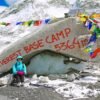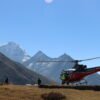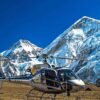Everest Base Camp Trek: An Adventure of a Lifetime
Nestled in the majestic Himalayas, the Everest Base Camp Trek and Everest Base Camp Helicopter Tour offer adventurers a once-in-a-lifetime experience, each with its own unique thrills and challenges. Whether you choose to trek through rugged terrain or soar above the world's highest peaks in a helicopter, both journeys promise breathtaking views, cultural encounters, and unforgettable memories. In this comprehensive guide, we'll delve into the intricacies of planning, experiencing, and comparing these two remarkable adventures.
I. Introduction
A Brief Overview of Everest Base Camp Trek
The Everest Base Camp Trek is a legendary expedition that attracts thousands of trekkers from around the globe each year. Stretching over approximately 130 kilometers round trip, the trek winds through the Khumbu region of Nepal, offering stunning views of snow-capped peaks, picturesque villages, and diverse landscapes.
Introduction to Everest Base Camp Helicopter Tour
For those seeking a quicker and more accessible alternative to traditional trekking, the Everest Base Camp Helicopter Tour provides an exhilarating aerial adventure. Departing from Kathmandu, this tour offers panoramic views of the Himalayas, including Mount Everest, without the physical exertion required for trekking.

II. Planning Your Trek
Choosing the Right Time of Year
Selecting the optimal time to embark on the Everest Base Camp Trek is crucial for a safe and enjoyable journey. The primary trekking seasons are spring (March to May) and autumn (September to November), when the weather is relatively stable, and skies are clear.
Obtaining Permits and Permissions
Before setting out on the trek, it's essential to obtain the necessary permits and permissions from the Nepalese government. These include the Sagarmatha National Park Entry Permit and the Khumbu Pasang Lhamu Rural Municipality Entry Permit.
Physical Preparation for the Trek
Preparing your body for the physical demands of the trek is vital to ensure a successful journey. Engaging in regular cardiovascular exercise, strength training, and hiking with a loaded backpack can help build stamina and endurance.
III. Route Details
Kathmandu to Lukla: The Beginning of the Journey
The trek typically begins with a scenic flight from Kathmandu to Lukla, a small town in the Khumbu region. From Lukla, trekkers embark on a multi-day journey through the heart of the Himalayas.
Trekking Through Namche Bazaar
One of the highlights of the trek is passing through Namche Bazaar, the bustling commercial hub of the Khumbu region. Here, trekkers can acclimatize, explore local markets, and immerse themselves in Sherpa culture.
Acclimatization Stops and Their Importance
Acclimatization is crucial for preventing altitude sickness and ensuring a safe trekking experience. Along the route, designated acclimatization stops allow trekkers to rest and adjust to the thinning air at higher altitudes.
Reaching Everest Base Camp
After days of trekking through rugged terrain and crossing suspension bridges, trekkers finally arrive at Everest Base Camp. Located at an altitude of 5,364 meters, this iconic destination offers unparalleled views of Mount Everest and the surrounding peaks.
IV. Accommodation Options
Teahouses Along the Trekking Route
Throughout the trek, trekkers have the option to stay in rustic teahouses, which provide basic amenities such as meals, lodging, and warm hospitality. Staying in teahouses offers an authentic glimpse into local mountain life.
Camping Options
For those seeking a more immersive wilderness experience, camping along the trekking route is an alternative accommodation option. Camping allows trekkers to sleep under the stars and enjoy the tranquility of the Himalayan landscape.
Luxury Lodges for Comfort Seekers
For travelers who prefer a touch of luxury amidst the rugged terrain, upscale lodges and resorts are available along the trekking route. These accommodations offer modern amenities, gourmet cuisine, and stunning mountain views.
V. Highlights Along the Way
Stunning Views of the Himalayas
One of the most awe-inspiring aspects of the Everest Base Camp Trek is the opportunity to witness the majestic beauty of the Himalayan mountain range up close. From panoramic vistas to up-close encounters with towering peaks, every moment on the trek is a feast for the eyes.
Unique Cultural Encounters with Sherpa Communities
Throughout the trek, trekkers have the chance to interact with the indigenous Sherpa communities that call the Khumbu region home. From visiting monasteries to participating in traditional ceremonies, these cultural exchanges add depth and meaning to the journey.
Visiting Tengboche Monastery
A highlight of the trek is a visit to Tengboche Monastery, a centuries-old Buddhist monastery nestled amidst the Himalayas. Here, trekkers can witness daily rituals, soak in the spiritual ambiance, and enjoy panoramic views of Everest and its neighboring peaks.
VI. Challenges and Risks
Altitude Sickness: Symptoms and Prevention
Altitude sickness, also known as acute mountain sickness (AMS), is a common concern for trekkers ascending to high altitudes. Symptoms may include headache, nausea, dizziness, and fatigue. Adequate acclimatization, hydration, and gradual ascent are essential for preventing AMS.
Weather Hazards
The Himalayan weather is notoriously unpredictable, with conditions ranging from clear skies to snowstorms and high winds. Trekkers must be prepared for sudden changes in weather and pack accordingly with layers, waterproof gear, and sturdy footwear.
Physical Endurance and Fitness Requirements
The Everest Base Camp Trek is physically demanding, requiring trekkers to navigate steep ascents, rocky terrain, and high altitudes. Prior hiking experience and a good level of fitness are recommended to fully enjoy the trekking experience.
VII. Everest Base Camp Helicopter Tour Overview
An Alternative to Traditional Trekking
For travelers with time constraints or physical limitations, the Everest Base Camp Helicopter Tour offers a convenient and exhilarating alternative to traditional trekking. This aerial adventure allows participants to experience the beauty of the Himalayas from a unique perspective.
Highlights of the Helicopter Tour Experience
During the helicopter tour, passengers can enjoy panoramic views of Mount Everest, Lhotse, Nuptse, and other iconic peaks from the comfort of a helicopter. The tour typically includes a landing at Everest Base Camp or Kalapatthar for a close-up view of the world's highest mountain.
VIII. Logistics of Helicopter Tour
Departure Points and Timing
The helicopter tour usually departs from Kathmandu or Lukla, depending on the chosen itinerary. Flights are subject to weather conditions and may be rescheduled or canceled for safety reasons.
Duration and Itinerary
The duration of the helicopter tour varies depending on the chosen package and itinerary. Typically, the tour lasts a few hours and includes aerial sightseeing, landing at Everest Base Camp, and photo opportunities.
Cost Considerations
The cost of the Everest Base Camp Helicopter Tour varies depending on factors such as the duration of the flight, the number of passengers, and the inclusion of additional services such as meals or guided tours.

IX. Benefits of Helicopter Tour
Spectacular Aerial Views of Everest and Surrounding Peaks
The helicopter tour offers passengers a bird's-eye view of Mount Everest and the surrounding Himalayan peaks, allowing for unparalleled photo opportunities and panoramic vistas.
Time-Efficient Alternative for Those with Limited Time
For travelers with limited time or physical limitations, the helicopter tour provides a convenient and time-efficient way to experience the majesty of Everest without the need for trekking.
Accessibility for Individuals with Physical Limitations
Unlike trekking, which requires a certain level of physical fitness and endurance, the helicopter tour is accessible to individuals of all ages and fitness levels, making it an inclusive option for experiencing Everest.
X. Comparing Trekking and Helicopter Tour
Trekking: Immersive Experience and Physical Challenge
Trekking to Everest Base Camp offers a deeply immersive experience, allowing trekkers to connect with nature, challenge themselves physically, and forge lasting memories with fellow adventurers.
Helicopter Tour: Convenience and Panoramic Views
The helicopter tour provides a convenient and time-efficient way to experience the beauty of Everest, with minimal physical exertion required. Passengers can enjoy breathtaking views of the Himalayas from the comfort of a helicopter.
XI. Environmental Considerations
Ecotourism Practices on the Trek
Responsible trekking practices, such as minimizing waste, conserving water, and respecting local customs and traditions, are essential for minimizing the environmental impact of trekking in the Everest region.
Carbon Footprint of Helicopter Tours
While helicopter tours offer a convenient way to experience Everest, they also have a higher carbon footprint compared to trekking. It's important for operators to implement eco-friendly practices and offset carbon emissions to mitigate environmental impact.
XII. Cultural Impact
Supporting Local Communities through Trekking
Trekking in the Everest region provides valuable economic opportunities for local communities, including Sherpa villages and small businesses that rely on tourism for their livelihoods.
Responsible Tourism Practices on Helicopter Tours
Operators of helicopter tours must prioritize responsible tourism practices, such as supporting local communities, respecting cultural heritage sites, and minimizing noise pollution in sensitive areas.
XIII. Safety Measures
Safety Standards of Trekking Agencies
When choosing a trekking agency, it's essential to prioritize safety and select a reputable company with experienced guides, proper equipment, and emergency evacuation protocols in place.
Helicopter Tour Safety Protocols
Helicopter tour operators adhere to strict safety standards, including regular maintenance inspections, trained pilots, and emergency response procedures to ensure the safety of passengers and crew.
XIV. Conclusion
Summarizing the Trekking and Helicopter Tour Experiences
Both the Everest Base Camp Trek and Everest Base Camp Helicopter Tour offer unique opportunities to experience the majesty of Everest and the Himalayas. Whether you choose to trek through rugged terrain or soar above the clouds in a helicopter, both adventures promise unforgettable memories and breathtaking views.
Personal Reflections on Choosing the Right Adventure
Ultimately, the decision to trek or take a helicopter tour depends on individual preferences, physical fitness, and time constraints. Each option offers its own set of rewards and challenges, ensuring a truly memorable experience for every adventurer.
XV. Tips for Future Travelers
Packing Essentials for Both Trekking and Helicopter Tours
When preparing for your Everest adventure, be sure to pack essential items such as warm clothing, sturdy footwear, sunscreen, and plenty of water. Additionally, don't forget to bring a camera or smartphone to capture the stunning scenery along the way.
Final Considerations Before Embarking on Your Journey
Before embarking on your Everest journey, take the time to research and plan accordingly. Whether you choose to trek to Everest Base Camp or take a helicopter tour, be sure to prioritize safety, respect the environment, and embrace the spirit of adventure.




